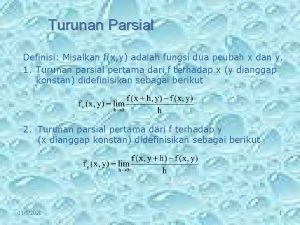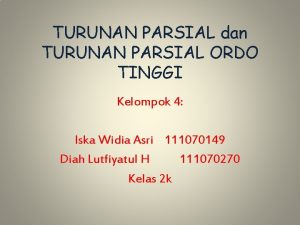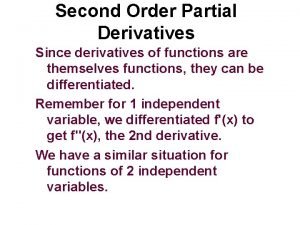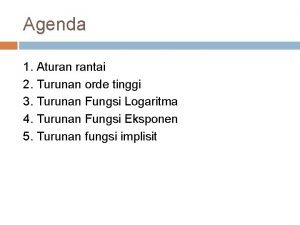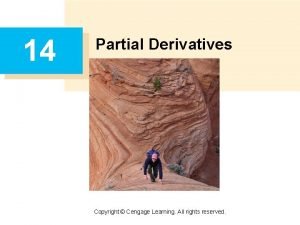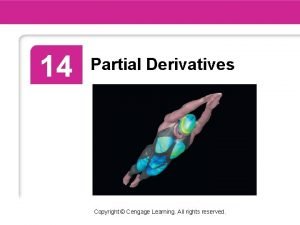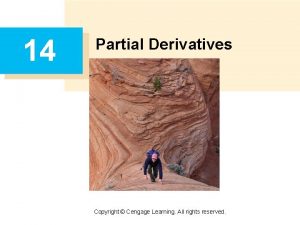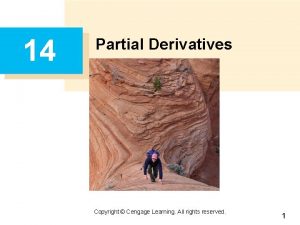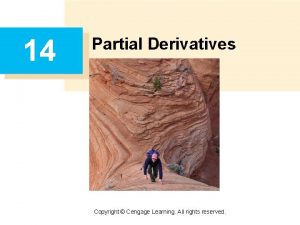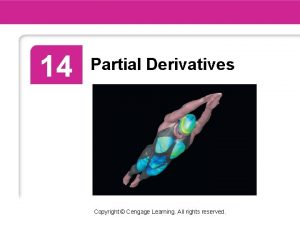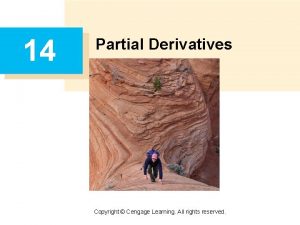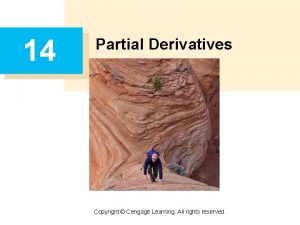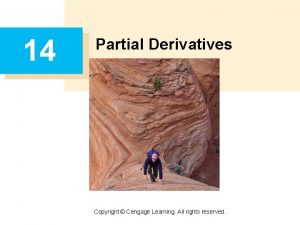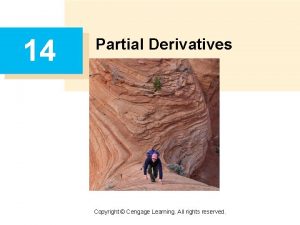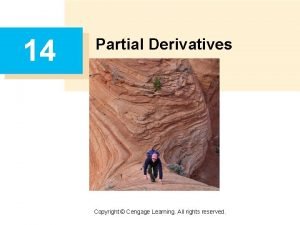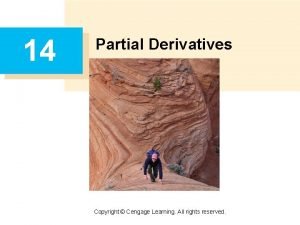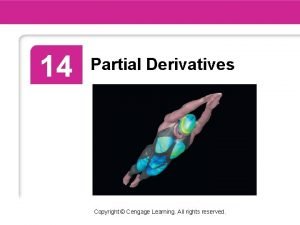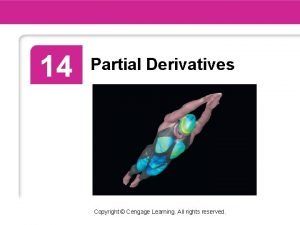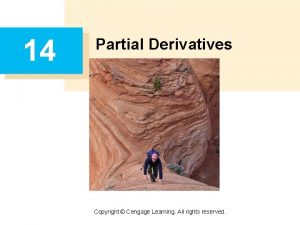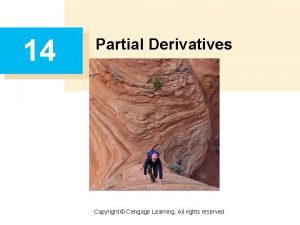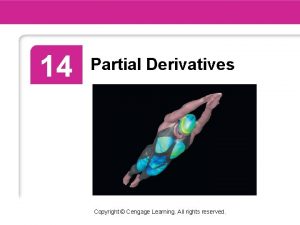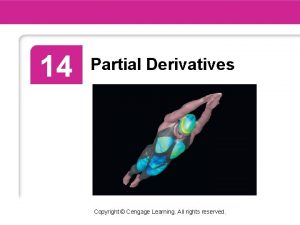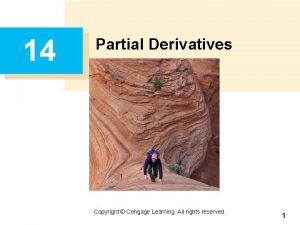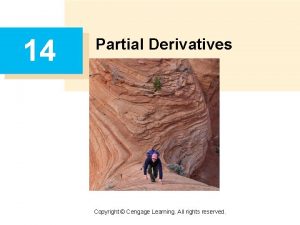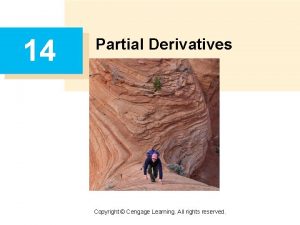14 Partial Derivatives Copyright Cengage Learning All rights




























- Slides: 28

14 Partial Derivatives Copyright © Cengage Learning. All rights reserved.

14. 2 Limits and Continuity Copyright © Cengage Learning. All rights reserved.

Limits and Continuity Let’s compare the behavior of the functions and as x and y both approach 0 [and therefore the point (x, y) approaches the origin]. 3

Limits and Continuity Tables 1 and 2 show values of f (x, y) and g (x, y), correct to three decimal places, for points (x, y) near the origin. (Notice that neither function is defined at the origin. ) Values of f (x, y) Table 1 4

Limits and Continuity Values of g (x, y) Table 2 5

Limits and Continuity It appears that as (x, y) approaches (0, 0), the values of f (x, y) are approaching 1 whereas the values of g (x, y) aren’t approaching any number. It turns out that these guesses based on numerical evidence are correct, and we write and does not exist 6

Limits and Continuity In general, we use the notation to indicate that the values of f (x, y) approach the number L as the point (x, y) approaches the point (a, b) along any path that stays within the domain of f. 7

Limits and Continuity In other words, we can make the values of f (x, y) as close to L as we like by taking the point (x, y) sufficiently close to the point (a, b), but not equal to (a, b). A more precise definition follows. 8

Limits and Continuity Other notations for the limit in Definition 1 are and f (x, y) L as (x, y) (a, b) For functions of a single variable, when we let x approach a, there are only two possible directions of approach, from the left or from the right. We know that if limx a- f (x) limx a+ f (x), then limx a f (x) does not exist. 9

Limits and Continuity For functions of two variables the situation is not as simple because we can let (x, y) approach (a, b) from an infinite number of directions in any manner whatsoever (see Figure 3) as long as (x, y) stays within the domain of f. Figure 3 10

Limits and Continuity Definition 1 says that the distance between f (x, y) and L can be made arbitrarily small by making the distance from (x, y) to (a, b) sufficiently small (but not 0). The definition refers only to the distance between (x, y) and (a, b). It does not refer to the direction of approach. Therefore, if the limit exists, then f (x, y) must approach the same limit no matter how (x, y) approaches (a, b). 11

Limits and Continuity Thus, if we can find two different paths of approach along which the function f (x, y) has different limits, then it follows that lim(x, y) (a, b) f (x, y) does not exist. 12

Example 1 Show that does not exist. Solution: Let f (x, y) = (x 2 – y 2)/(x 2 + y 2). First let’s approach (0, 0) along the x-axis. Then y = 0 gives f (x, 0) = x 2/x 2 = 1 for all x 0, so f (x, y) 1 as (x, y) (0, 0) along the x-axis 13

Example 1 – Solution cont’d We now approach along the y-axis by putting x = 0. for all y 0, so Then f (x, y) – 1 as (x, y) (0, 0) along the y-axis (See Figure 4. ) Figure 4 14

Example 1 – Solution cont’d Since f has two different limits along two different lines, the given limit does not exist. (This confirms the conjecture we made on the basis of numerical evidence at the beginning of this section. ) 15

Limits and Continuity Now let’s look at limits that do exist. Just as for functions of one variable, the calculation of limits for functions of two variables can be greatly simplified by the use of properties of limits. The Limit Laws can be extended to functions of two variables: the limit of a sum is the sum of the limits, the limit of a product is the product of the limits, and so on. In particular, the following equations are true. The Squeeze Theorem also holds. 16

Continuity 17

Continuity We know that evaluating limits of continuous functions of a single variable is easy. It can be accomplished by direct substitution because the defining property of a continuous function is limx a f (x) = f (a). Continuous functions of two variables are also defined by the direct substitution property. 18

Continuity The intuitive meaning of continuity is that if the point (x, y) changes by a small amount, then the value of f (x, y) changes by a small amount. This means that a surface that is the graph of a continuous function has no hole or break. Using the properties of limits, you can see that sums, differences, products, and quotients of continuous functions are continuous on their domains. Let’s use this fact to give examples of continuous functions. 19

Continuity A polynomial function of two variables (or polynomial, for short) is a sum of terms of the form cxmyn, where c is a constant and m and n are nonnegative integers. A rational function is a ratio of polynomials. For instance, f (x, y) = x 4 + 5 x 3 y 2 + 6 xy 4 – 7 y + 6 is a polynomial, whereas is a rational function. 20

Continuity The limits in (2) show that the functions f (x, y) = x, g(x, y) = y, and h(x, y) = c are continuous. Since any polynomial can be built up out of the simple functions f, g, and h by multiplication and addition, it follows that all polynomials are continuous on. Likewise, any rational function is continuous on its domain because it is a quotient of continuous functions. 21

Example 5 Evaluate Solution: Since f (x, y) = x 2 y 3 – x 3 y 2 + 3 x + 2 y is a polynomial, it is continuous everywhere, so we can find the limit by direct substitution: (x 2 y 3 – x 3 y 2 + 3 x + 2 y) = 12 23 – 13 22 + 3 1 +2 2 = 11 22

Continuity Just as for functions of one variable, composition is another way of combining two continuous functions to get a third. In fact, it can be shown that if f is a continuous function of two variables and g is a continuous function of a single variable that is defined on the range of f, then the composite function h = g f defined by h (x, y) = g (f (x, y)) is also a continuous function. 23

Functions of Three or More Variables 24

Functions of Three or More Variables Everything that we have done in this section can be extended to functions of three or more variables. The notation means that the values of f (x, y, z) approach the number L as the point (x, y, z) approaches the point (a, b, c) along any path in the domain of f. 25

Functions of Three or More Variables Because the distance between two points (x, y, z) and (a, b, c) in is given by , we can write the precise definition as follows: for every number ε > 0 there is a corresponding number > 0 such that if (x, y, z) is in the domain of f and 0< < then | f (x, y, z) – L | < ε 26

Functions of Three or More Variables The function f is continuous at (a, b, c) if For instance, the function is a rational function of three variables and so is continuous at every point in except where x 2 + y 2 + z 2 = 1. In other words, it is discontinuous on the sphere with center the origin and radius 1. 27

Functions of Three or More Variables We can write the definitions of a limit for functions of two or three variables in a single compact form as follows. 28
 Copyright cengage learning. powered by cognero
Copyright cengage learning. powered by cognero Copyright 2015 all rights reserved
Copyright 2015 all rights reserved Copyright 2015 all rights reserved
Copyright 2015 all rights reserved Dell all rights reserved copyright 2009
Dell all rights reserved copyright 2009 Copyright © 2018 all rights reserved
Copyright © 2018 all rights reserved Partial derivative
Partial derivative Misalkan fx = x + 2 untuk x
Misalkan fx = x + 2 untuk x Turunan parsial tingkat tinggi
Turunan parsial tingkat tinggi Partial derivative
Partial derivative Contoh soal aturan rantai kalkulus
Contoh soal aturan rantai kalkulus Tree diagram partial derivatives
Tree diagram partial derivatives Delmar cengage learning medical terminology
Delmar cengage learning medical terminology Chapter 5 the cardiovascular system
Chapter 5 the cardiovascular system Cengage learning heart diagram
Cengage learning heart diagram South-western cengage learning
South-western cengage learning 2009 delmar cengage learning
2009 delmar cengage learning 2009 delmar cengage learning
2009 delmar cengage learning Cengage learning heart diagram
Cengage learning heart diagram Delmar learning medical abbreviations
Delmar learning medical abbreviations Cengage learning australia
Cengage learning australia Measuring and recording apical pulse
Measuring and recording apical pulse Whille
Whille Cengage learning
Cengage learning Wadsworth cengage learning
Wadsworth cengage learning Cengage learning
Cengage learning Cengage learning plant cell
Cengage learning plant cell Cengage learning
Cengage learning Cengage learning
Cengage learning Brooks cole cengage learning
Brooks cole cengage learning






